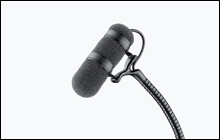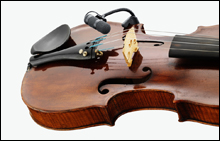
FIDDLE STYLES:
THE DPA 4099 AND MY SEARCH FOR THE PERFECT FIDDLE SOUND
My search for the perfect amplified fiddle sound goes back some 30 years to when I started my first rock band at Leicester University in 1975. I was mostly playing guitar (very badly, as I later realised) to start with, but the violin was a useful novelty and I could imagine I was Jean Luc Ponty playing with Frank Zappa, or Darryl Way with Curved Air. For amplification I attached a cheap contact pickup designed for acoustic guitar. Fortunately I’ve forgotten the name of the pickup (if you can remember being in the Speedy Bears, you weren’t really there!) but I still have a cassette of the resulting sound. Thin, scratchy and piercing are the three most generous adjectives I can think of.
Graduation came and went, and I inexplicably decided to abandon my proposed career in Geology in favour of prog rock. This being 1978 you could say my timing was poor to say the least. My first unemployment cheque (and that gives you an idea of how quickly my career got off the ground!) went on a Barcus-Berry violin transducer. Here at last was a decent sound which didn’t howl with feedback at the least provocation. With all the treble turned off and the bass turned up full on a guitar combo it sounded quite warm and almost like a violin. It was a little metal “T” shape which attached to the bridge with a sticky blue-tac like substance . Its main drawback was that the socket which fastened to the tailpiece) was for a ¼ inch minijack. The lead it came with was thin and insubstantial, lasting only a few months. There followed a long series of guitar leads with ¼ inch jacks soldered on. Many was the passionate and spaced-out solo rudely interrupted by the sudden failure of one of these leads.
This pickup lasted for about a decade, outliving the Speedy Bears by some years before it gave up the ghost. By this time Barcus-Berry had “upgraded” the model to one which appeared to have a much lower output and wouldn’t operate without a preamp.I then switched to a Fishman; also a transducer, this time wedging into the slot in the bridge. This gave a bright, clean sound with lots of output, though any slight movement within the slot was liable to alter the tone, and it also shared the minijack problem. In addition, there was a certain distinctive thinness to the sound which always left me slightly unsatisfied.
I stuck with Fishman for many years, playing gigs everywhere from the Albert Hall (with Goth-Rockers All About Eve) to the local pub (with anyone that would have me) until I decided to give The LR Baggs bridge a try. I’d always been suspicious of built-in bridge pickups, since I was aware that a violin bridge has limited life- sooner or later it’s going to weaken and bend. However it came with an endorsement from my hero Mark O’Connor, so it was worth a shot. It was something of a leap of faith, since it had to be fitted and wired in a violin shop’. Effectively I couldn’t try it before buying it, and the cost was about double what I’d paid for the Fishman. The result, however, was dramatically better. Gone was the thin sound. Gone was any need for a preamp or EQ box. Gone also was the problem with leads, as the Baggs came with a Carpenter jack socket. This attached to the side of the fiddle and allowed a standard 1 inch guitar lead to be used. The Baggs gave a fat, rock-solid sound that would cut through any racket from the rest of the band. For most of my gigs by this time I was using an AER combo, perfect for acoustic instruments. For larger gigs I took an XLR out of the back of the amp to a PA. Here surely was the end of my quest- the best fiddle sound that money could buy.This is what I believed until I discovered the DPA (Danish Pro Audio);. I first came across it when doing a job with the RSC- playing bluegrass music on a production of A Winter’s Tale, if you can believe it. The sound technician supplied the whole band with DPA 4061 omni mics. They were small and unobtrusive, attaching with a mute-like clip to the strings behind the bridge- though in the theatre situation I couldn’t really hear the result. At a gig in the Barbican with a choir and orchestra again the same mics turned up. In fact they are used by many if not most West End shows, orchestras and theatre productions; to take just one example, the recent “War of the Worlds” UK tour used no less than 37 DPA mics on the orchestra.
By this time I was writing “The Fiddle Handbook” for Hal Leonard, and was deep into researching every conceivable aspect of fiddle playing, including a chapter on amplifying the fiddle. My advice to everyone up to this point had been to buy a Baggs bridge pickup, but out of curiosity I finally threw caution to the wind and got hold of my own DPA mic.
I got the 4099 model, a tiny unidirectional shotgun mic on a flexible “gooseneck” which attaches to the fiddle with a lightweight mounting bracket to the left of the chinrest. The mic points at the F-hole or bridge. A thin cable leads off this to an XLR adaptor, which you can either clip to your belt or trail on the floor.
First of all I tried it through my AER amp, using the XLR input. If you’re hoping to use a DPA through an old fashioned guitar combo with only jack sockets, forget it!
At around £430 for the DPA I was expecting good results, and I wasn’t disappointed. The sound was immediately impressive. The tone I was used to from the Baggs suddenly seemed monolithic and dry by comparison. Here was a sound full of colour, light and shade. Without wishing to sound like a pretentious wine critic, it was full of the sounds of wood and varnish, whispering to me from every crevice of the instrument. I’d got used to a condensed, compressed recreation of the fiddle sound, but here was the real thing-, delicate, sensitive and intimate.
The big danger with any mic, even one as directional and the DPA, is feedback. When it got within about two feet of the amp there was an immediate low-end howl, so I quickly had to get used to holding the fiddle away whilst making amp adjustments. However, the DPA is designed with feedback resistance very much in mind and it’s far less of a problem than I’d expected. Sitting with my amp around three feet behind me and to my left, I experience little or no feedback problems.
My first trial of the mic direct through a PA was a miserable failure since I hadn’t realised the DPA needs phantom power. My AER amp had been supplying this without me even realising, but with a PA you have to ask for it. Once this was sorted out I was more than pleased with the result, and spent the rest of the gig revelling in what suddenly sounded like a new and very expensive instrument.
Of course nothing is perfect, and when I tried it on a noisy and chaotic gig with drums, electric guitars and a soundman who wanted to be elsewhere it didn’t perform nearly as well. I couldn’t get sufficient volume and clarity without coming close to feedback. In such situations, where basically the best you can hope for is to actually hear yourself and be heard, the perfection of sound that a DPA will give you is wasted anyway, and you’re better off using a pickup. The DPA comes into its own where you have sufficient space, both physically and acoustically, for the fiddle to be heard clearly. On a theatre or concert hall stage, with a decent PA, and an acoustic band I don’t think you’ll get a better sound than the DPA. I spoke to Grappelli specialist Tim Kliphuis, who always uses the DPA for outdoor performances, and also in the studio in combination with a mic placed above the violin. He is very happy with it and was keen to recommend it to me.
I’m still experimenting and am currently using a blend of both the DPA and my Baggs bridge pickup . The Baggs performs best at the bottom end, giving a powerful and solid foundation to the sound, whilst the DPA provides sensitivity in the middle and a beautifully sweet high end. It may have taken me thirty years, but I believe the search is over and I’ve finally got the best sound that money can buy.
Return to fiddlingaround.co.uk homepage
Chris Haigh is a freelance fiddle player and writer based in London. He has played on over 70 albums in a wide range of styles, and has had three books published; ""Fidding around the World", "Any Fool can write Fiddle Tunes" and "The Fiddle Handbook".



